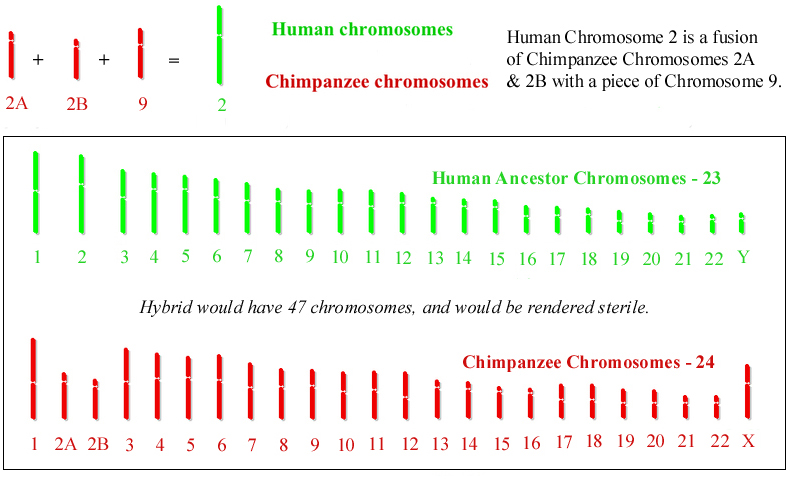A Problem With Human Evolution - A Question Posed To Everyone
Evolution is described as the origin of species through the product of cumulative evolutionary changes over billions of years. Basically, a minor change in the code that makes up a life form, past on to it descendants, combine with additional changes to their descendants over many years, to make a new species. So in order for a change to be carried on, the first organism with that change must reproduce, as must their descendants.
Human and chimpanzees are like species. According to the theory of evolution, we share a common ancestor. Genetic research has yielded findings that state out DNA is 99% the same. One key difference between the species is chromosome 2. Humans have 46 chromosomes (23 chromosome pairs). That is two sex chromosomes (either XX female or XY male) and 44 autosomes . Autosomes work the same in either male or female, and everyone has two copies of each chromosome 1 through 22. One from the mother and the second from the father. The same is true for all species, except for the number of chromosome pairs and the sex chromosomes (some species have different chromosomes and different methods of combination).
Chimpanzees (and other ape species) however have 48 chromosomes (24 pairs). Two sex chromosomes and 46 autosomes. This means that somewhere along the line, the ancestor of humans made the change from 48 chromosomes to only 46. Scientists have discovered that this happened by combining two chromosomes. There was a fusion even in which what is known in chimpanzees as Chromosomes 2A and 2B fused to make what is in humans Chromosome 2. Also a part of Chromosome 9 contributed to the mix. All humans have this fused chromosome. This suggests it was single event. This means that an early hominid experienced such a mutation. He (for the sake of reference, it could have just as easily been a she) has chromosomes 1, and 3-22 from one parent with fused Chromosome 2. That would make 22 autosomes. Then the normal 1, 2A, 2B and 3-22 from the other parent, making a total if 23 autosomes. Combined with the two sex chromosomes would make 47. This presents a problem.
In order for meiosis to occur and make gametes (sperm or eggs) there must be an even number of chromosomes. They must be in pairs. If they are uneven, the organism is sterile. For example, mules, which are the mating of a horse and a donkey. Donkeys have 62 chromosomes and horses have 64. Mules would then have 63, and it is for this reason they are generally sterile. This human ancestor would have experienced the same problem. While he may have been perfectly healthy with all the required genetic material to build a healthy body, the inability for meiosis would mean the mutation couldn't be spread. There are a few scenarios in which this could happen.
 Scenario 1 - Two human-chimpanzee ancestors produce an embryo with 47 chromosomes
Scenario 1 - Two human-chimpanzee ancestors produce an embryo with 47 chromosomes
This embryo would grow, become fully formed and be born. As healthy as he may appear to be, he would be sterile. He could mate as many times as he liked but with out meiosis, no offspring would result.
Scenario 2 - Human-chimpanzee ancestor with 48 chromosomes develops a mutation only in the germ line
This human ancestor may have had 48 chromosome in every cell in his body, except one gamete in which the fusion event occurred. This gamete fused with another to make an embryo. This would delay the end of the bloodline only one generation as the offspring would experience the same problem as in scenario 1.
Scenario 3 - Human-Chimpanzee ancestor develops a 49th chromosome.
The fusion event happen as a result of merging of an extra copy of 2A and 2B. So all the normal chimpanzee chromosomes would be present with an extra new chromosome, human chromosome 2. The uneven number would render this organism sterile.
Scenario 4 - Human-Chimpanzee develops Chromosome 2, but lacks other chromosomes, or extra copies of others
A parent had an even number of chromosomes after the fusion event by having extra copies of another chromosome or by missing a chromosome. Such an organism could have experienced major mutations. This would normally be lethal, but if such a creature survived to adulthood and mated, there are a few possible outcomes.
4A - If the parent was missing chromosome, this mutation could prove lethal to a child if passed on for require genetic material could be absent.
4B - The half of the genetic material that was passed on might not match up properly with that passed on from the mate.
4C - Required chromosomes could be passed on along with Chromosome 2, creating a sterile offspring like in scenario 1.
Scenario 5 - Human-Chimpanzee ancestor with Chromosome 2 was able to breed with either species through unique circumstances
Through a combination of any of the above scenarios this organism with the first copy of Chromosome 2 was able to bred with what ever would become either chimpanzee or human. The lack of Chromosome 2 in chimpanzees proves this did not occur. Also the offspring would still be surrounded by other like organisms with the standard of 48 chromosome. There would still the risk of sterility as seen in above scenarios, or lethal mutation.
The question is, can science explain how these problems were solved and humans changed from mere apes to what we currently are?

